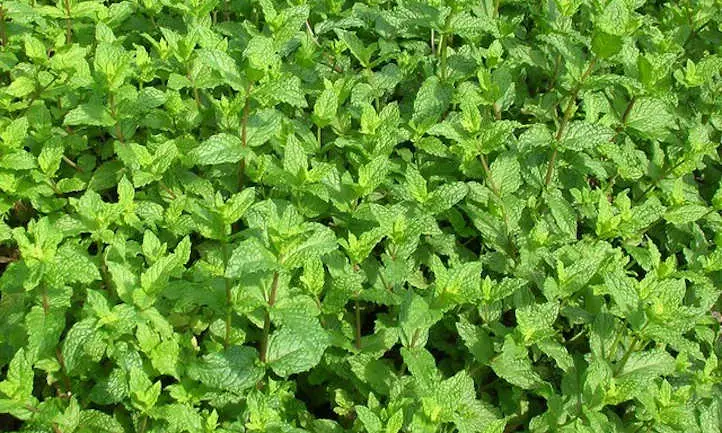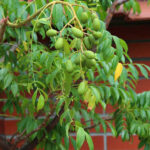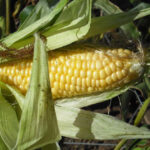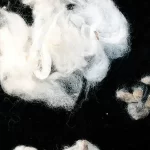Mint is not just for mojitos! It’s for minted pea soup; stirring into baby boiled potatoes with lashings of salty butter; tossing into a Greek salad with chopped tomatoes and cucumbers; whipping into cream, sugar and chocolate to make chocolate chip ice cream…. is your mouth watering yet? Growing mint is a must for everyone and here are even more reasons to grow it!
Used for its culinary and health benefits for thousands of years, mint is a powerhouse of health benefits containing vitamin A, C, B12, calcium, copper and manganese to name a few. Its antioxidant, anti-inflammatory, decongestant properties help in the fight against seasonal viruses, relieving sore throats and stuffy noses, and all while making you smell minty fresh!
Ever wondered why desserts come with a sprig of mint? Well, eating fresh mint helps stimulate the production of digestive enzymes and relieves indigestion, acid reflux and nausea, so might come in handy after a heavy meal. The uplifting aroma of mint can also raise serotonin levels in the brain, boosting oxygen flow throughout the body, relaxing muscles and promoting more positive energy.
Still not convinced? Then how about the fact that mint it’s probably the easiest herb to grow, undemanding and virtually indestructible. It’s the perfect herb for the beginner.
Quick Care Guide
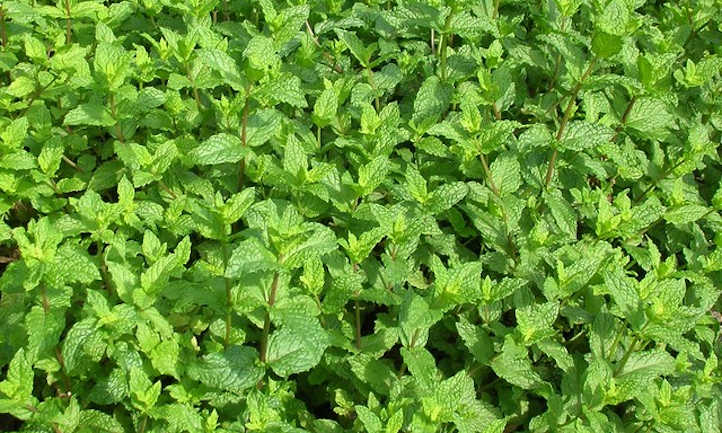
| Common Name(s) | Garden or spearmint; peppermint; eau de cologne mint or orange mint; water mint; pineapple or apple mint and pennyroyal. |
| Scientific Name | Mentha spicata; Mentha x piperita; Mentha citrata; Mentha aquatica; Mentha suaveolens and Mentha pulegium |
| Days to Harvest | 90 days to maturity |
| Light | Full sun to partial shade |
| Water: | Frequent watering to maintain soil moisture |
| Soil | Rich, moisture retentive, well draining |
| Fertilizer | Balanced NPK liquid fertilizer and compost |
| Pests | Aphids, spider mites, cutworms |
| Diseases | Powdery mildew, rust |
All About Mint
Mint is an aromatic, rhizomatous, herbaceous perennial herb. There are around 25 species within the genus Mentha and a multitude of hybrids, sub-species and lower ranks.
The most common varieties include, Mentha spicata (common, garden or spearmint), Mentha x piperita (peppermint), Mentha citrata (eau de cologne or orange mint), Mentha aquatica (water mint), Mentha suaveolens (apple mint or pineapple mint) and Mentha pulegium (pennyroyal).
The exact origins of mint are unknown. Mentha comes from the Greek word menthe, a mythological water nymph. Introduced to England by the Romans and later the New World by pilgrims, mint is widely distributed throughout the temperate areas of the globe and is naturalized in Eurasia, Australia, North America and Africa.
All mint plants have the characteristic mint family square stems. Species range in color from light to dark green, purple, brown and sometimes variegated green with white/cream margins as is common in apple mint and pineapple mint. Leaves also vary in shape from lance to ovate with smooth, shiny, rough or fuzzy textures.
Shoots appear in spring, developing into tall upright leafy stems averaging 1-2ft high. Leaves can be harvested from spring to early autumn, after which time they quickly deteriorate and the foliage dies back to ground level.
Mint spreads via underground rhizomes, or as stolons above the ground. If left to their own devices, mint plants can invade your garden. To keep in check, prune back when necessary or plant in pots to curb its wandering ways.
Mint flowers range from light pink, lilac and purple, on terminal spikes from June onwards. They are beneficial to wildlife attracting lots of pollinating insects such as hoverflies, lacewings and butterflies.
Types of Mint

Each species of mint has its own distinguishable aroma and flavor. Here are some of the mint family favorites.
Mentha spicata. Commonly known as the spearmint plant or garden mint. It’s slightly milder than peppermint and won’t overpower dishes, making it the go to mint herb in the kitchen. Leaves are bright green and narrower than other varieties such as Mentha x piperata.
Mentha x piperita vulgaris. Black peppermint is very aromatic and much stronger than the white peppermint plant Mentha x piperita officinalis. Stems and leaves are green flushed with purple. Leaves are larger than most mint varieties, toothed and oval shaped. Mentha x piperita is a natural hybrid between Mentha aquatica and Mentha spicata.
Mentha citrata. Also scientifically known as Mentha x piperita f. citrata and commonly known as orange mint, bergamot mint, and eau de cologne mint. A strong orange-scented mint with hints of lavender floral top notes. Orange mint has oval leaves, burgundy stems and leaves sometimes edged with purple.
Mentha x piperita f. citrata ‘Chocolate’. Commonly known as the chocolate mint plant, and its name is true: this mint smells and tastes like mint chocolate chip. It can be distinguished by its purple-brownish stems and leaf undersides which also extends to young apical growth which becomes green with maturity.
Mentha x piperita ‘Strawberry’. Commonly known as strawberry mint. A compact less vigorous variety with small mid-green leaves. The flavour is quite mild compared to other varieties and it has a fruity aroma with a hint of strawberry.
Mentha suaveolens. Commonly known as pineapple mint or apple mint, often has variegated leaves with white margin and a woolly or fuzzy texture. These variegated varieties provide ornamental as well as culinary value in the garden and are one of the best to grow for something a little bit different.
Planting Mint
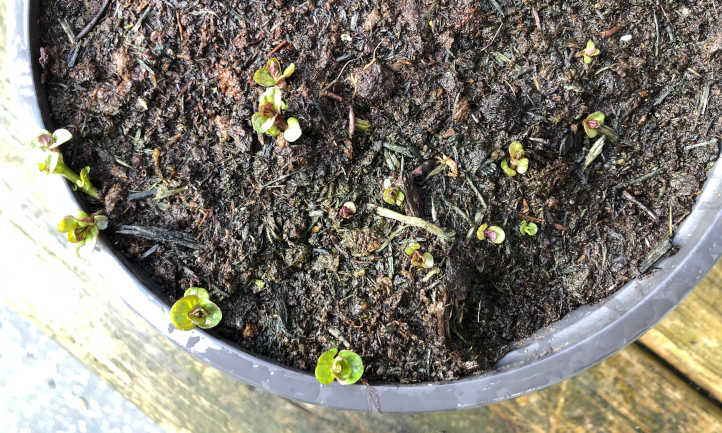
Sow mint seed indoors towards the end of winter to be transplanted into the garden once all risk of frost has passed. Alternatively, sow directly into warm spring soils dividing any clumps later in the season. Established root and stem cuttings taken the previous year, can be transplanted in spring.
Grow mint in rich, well drained, moisture retentive soils in partial shade. Planting mint in full sun is fine as long as the soil is kept moist. Plant mint varieties separately to keep their distinctive scent and flavour. A good way to do this is to grow mint types singly in large pots. To stop mint from becoming invasive, plant mint in pots and sink them into the ground. Just make sure to leave two inches of pot above soil level to prevent root runners reaching the soil. Be sure to divide container grown plants every year to avoid plants becoming pot bound.
Another good tip is to plant mint alongside physical barriers such as raised beds, walls, and paving to put a stop to its rampant nature!
No garden? No problem! Growing mint indoors on a sunny windowsill is easy. One or more of the most common mint varieties is usually available in the local garden centres or you can pick up fresh mint plants in your supermarket.
Caring For Mint Plant
Mint is pretty much maintenance free apart from pruning and watering.
Sun and Temperature
Mint thrives in cool to warm climates requiring a minimum of 4-5 hours direct sunlight per day. Grow mint in temperatures ranging from 55°F and 70°F (13°C and 21°C). Anything above 70°F will see mint plants begin to struggle.
Foliage will naturally die back with the first frosts, but the roots will survive in the ground even if frozen. Hardy to USDA zones 4 through to 9.
Water and Humidity
Watering mint first thing in the morning is best. Of course, if your mint is looking a bit sad and wilted during the day, a quick water and some emergency shading will help revive it.
Mints like soil moist, but not wet. Regularly check soil moisture levels and if it feels damp, then your plants are good. If dry, provide the area with a good drink. Mint can be watered using timed soaker hoses, or by hand with a hose or watering can, but always direct water at the soil and not the plant. Wet leaves in bright sun can cause scorch.
Normal ambient humidity of 70% in the greenhouse works for mint as long as it’s not too shaded; full sun to partial shade is preferred. Winter watering is not normally required except for the mint planter if it dries out.
Soil
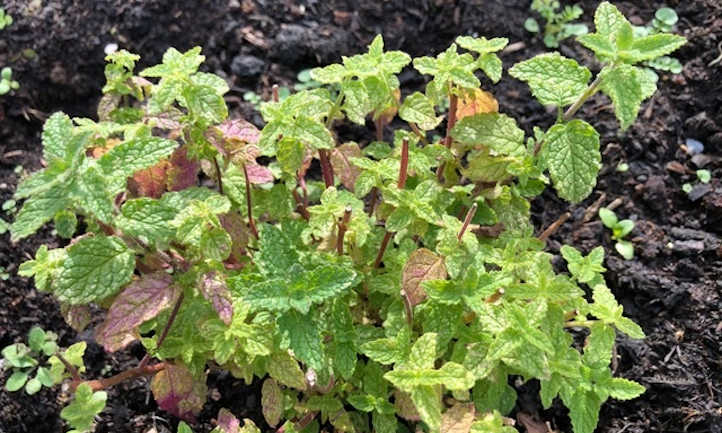
Mint can adapt to most soil types as long as they are rich in organic matter, moist but well drained. Sandy loams are probably best, but if you are stuck with a heavy clay don’t despair as it can be ameliorated by adding lots of organic matter to increase porosity and improve drainage. A soil pH between 6.0 and 7.0 is perfect.
Fertilizing
Mint does not require a lot of fertilizer. A good organic balanced NPK liquid fertilizer in spring will give the plant the boost it needs to get started. Follow this with light compost mulches throughout the summer to keep moisture in the soil and the same liquid feed every 4-6 weeks throughout the growing season.
Container grown mint requires more watering which can result in nutrient leaching. Apply a good organic top dress in spring mixed with a balanced slow release fertilizer.
Pruning
Harvesting regularly will keep growth in check and give you lots of lovely tender shoots throughout the summer. If not harvesting regularly, try to give your plant a good 2-3inch prune every month to encourage branching, healthy new growth and to prevent sprawling branches which can self-propagate.
Plant growth slows once flowering commences so prune any flowering spikes maintain foliage production. Alternatively, plants can be left to flower to encourage pollinators. In late autumn prune plants to 2 inches from ground level for winter.
Propagation
Making new plants from mint is easy and there are a number of ways to do it.
Sow seed in the spring. Mint seed is tiny, so mixing it with a small amount of horticultural sand will help you see where you have sown. Broadcast the mix over pre-watered general purpose compost in a seed tray and cover with ¼ inch of compost. Leave in a warm, bright location to germinate.
Cuttings can be taken throughout the season. Make a cutting below a leaf node with at least 4 inches of top growth. Fill a small pot with a mix of 30/70 of perlite and general purpose compost, dib holes around the side of the pots and stick the cuttings into the holes. Make sure at least two leaf nodes are below the surface of the growing media, and water. Roots usually appear within 2 weeks.
Another quick method is to place the cuttings into a glass of water, changing the water every few days. Roots should start to grow within a week.
Mint plants develop stolon roots towards the end of summer. Propagate root cuttings by simply cutting lengths of root into small pieces with at least two nodes on each. The nodes look similar to leaf nodes and will develop both roots and leaves. Lay the cuttings flat on top of 30/70 perlite/compost mix in flat trays or small pots, cover lightly and water.
Harvesting and Storing

Learning how to harvest mint is simple! No technical tools are required, just arm yourself with a pair of scissors!
Harvesting
Harvests will depend on the last and first frosts where you live. Harvest when plants are at least one foot tall, bushy and in good health. Harvest leaves in the morning and place in a plastic bag or wrap in damp kitchen paper to keep them hydrated.
Storing
Leaves will stay fresh for a week in a cool dark location such as the refrigerator. They can also be frozen in ice cubes to be added to cool summer drinks.
To dry, bring bunches of mint indoors and hang upside down in a warm, well ventilated room. Once dried, store in an airtight container. Mint loses a lot of flavor if it’s dehydrated with high heat, so let it air-dry instead.
Troubleshooting
Mint is relatively trouble free except for its constant bid to escape confinement.
Growing Problems
Mint invasion is probably one of the most common growing problems, but is easily resolved through good pruning methods and growing in pots.
Weak and leggy growth usually indicates wrong location or plants being overshadowed by their neighbours. To fix, space plants 2ft apart or grow mint in a different spot.
Finally, trying to keep your soil moist and not too wet or dry is a balancing act. Regularly check soil moisture levels, water when needed, and provide good drainage.
Pests
The smell of mint can deter most aphids (Aphidoidea), however, some such as greenfly cannot resist young new growth, feeding on the phloem sap and dehydrating the plant. Aphids are also a vector for a multitude of other plant diseases. They can be treated biologically through the release of beneficial insects that feed on them, such as ladybugs. Alternately, you can spray them with a good organic insecticidal soap or neem oil. Squishing them with fingers or a quick blast of water can help reduce numbers.
Spider mites (Tetranychidae) are arachnids and relatives of spiders and ticks. Spider mite infestation can be identified by fine webbing appearing between stems, and plants rapidly showing signs of decline. Similar to aphids they feed on plant juices causing leaves to yellow and drop off. To treat, oils can smother eggs and pyrethrins can be used to kill off adult mites. Remove and destroy the worst affected stems and entire plants if necessary to prevent their spread.
Cutworms (Agrotis spp.) are 1-2 inches in length and may overwinter in soils, re-emerging in spring in search of food. These troublesome critters move around just beneath or at the soil surface at night and sever young shoots at the soil line. Plants that looked fine one day are dead the next. Remove any cutworms you find. Clear decaying debris from around planted areas, as the debris provides ideal conditions for overwintering larva or for moths to lay new eggs. Bacillus thurigiensis (BT) spray can eliminate these annoying moth larvae.
Diseases
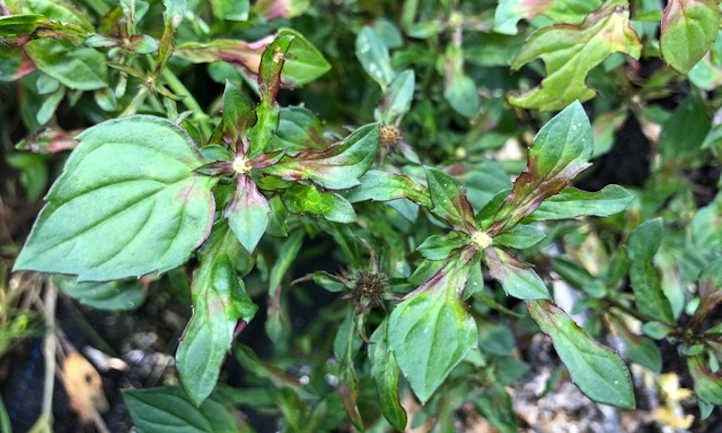
Powdery mildew is one of the main fungal diseases to affect mint, spread by spores carried on the wind. It thrives in hot, humid, shaded conditions and tends to grow as a white thick dust on leaves, inhibiting photosynthesis and hindering growth. Leaves eventually turn yellow, die and fall off. To prevent powdery mildew maintain good garden hygiene, removing infected foliage from plants and the ground to prevent reinfection in subsequent years. Prune overcrowded areas to allow good air circulation. Spray with an organic fungicide such as sulfur, neem oil or potassium bicarbonate, prior to or on first sight of disease.
Fungal rust forms yellow/orange spots on leaves and orange red pustules on their undersides. It spreads from plant to plant via wind or water droplets and once infected, plants can decline quickly. Early treatment with a good copper fungicide can slow the spread of the disease, but it is difficult to treat on mint. Prune off all signs of the disease well below the infected portions and destroy the pruned material. If necessary, cut back the mint to ground level and it should return in the spring.
Frequently Asked Questions
Q: Does mint come back every year?
A:Yes, as a herbaceous perennial, mint dies back in winter and regrows in spring the following year.
Q: Does mint keep bugs away?
A: Many insects do not like the smell of mint. Growing mint in pots around your cabbage family plants keep insects such as mealybugs and scale insects away from attacking your crops.
Q: How do I make my mint plant bushy?
A:Regular harvesting and pruning will help stems branch out, creating a more bushy appearance.

